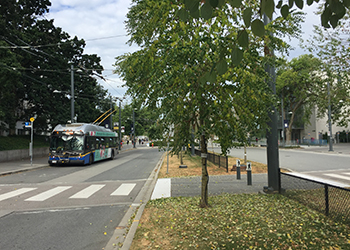
Physical inactivity and obesity represent two of the greatest public health threats in Canada. The 2007-2008 Canadian Community Health Survey indicates that almost half of Canadian adults are physically inactive, while about one-quarter are obese. Given that both physical inactivity and obesity are strong predictors of coronary artery disease, stroke, and type 2 diabetes, they impose a significant burden on the Canadian health care system.
Recognition is growing that health costs are associated with transportation investments and land-use decisions. A number of studies have suggested that investments in improved public transit service are associated with increases in physical activity and lower obesity rates, both of which lead to considerable health benefits. Conversely, increased time spent in cars is associated with higher obesity rates and lower levels of physical activity. Investments in transit that reduce travel time and increase comfort and convenience would likely reduce sedentary time in cars, and increase transit use and walking.
Data access has been approved for a study which aims to fill a critical gap in our understanding of built environment impacts on health care utilization costs via physical activity and obesity. The research is being led by Professor Lawrence Frank at the University of British Columbia’s School of Population and Public Health, and funded by the Canadian Institutes of Health Research. The innovative study is guided by a partnership co-led with Dr. Jat Sandhu from Vancouver Coastal Health Authority and includes support and direct engagement from the Real Estate Foundation of BC, City of Vancouver, METRO Vancouver, and TransLink. Dr. Andy Hong with the Health and Community Design Lab at UBC is also playing a leadership role in the study.
“Despite efforts both in the public health sector to promote physical activity and healthy living to decrease morbidity and mortality related to obesity, and also in the transportation and land-planning sector to increase walkability of neighborhoods, little work has focused on explicitly linking these efforts to health care cost savings,” says Professor Frank.
Dr. Frank believes that this may be due, in part, to historical divisions between these disciplines, and is hoping to overcome this obstacle by recruting a broad range of partners and researchers with diverse backgrounds to the research team. By bringing together team members from the fields of public health and urban planning, Professor Frank aims to better understand the health implications resulting from interactions between these two sectors.
This pioneering study will combine and analyze data from these generally disconnected sectors, paving the way for future studies connecting land use, transportation behavior, and population health outcomes.
In addition to the potential impact within the region to directly inform policymakers involved in making land-use decisions, the study’s exploration of a novel method of linking diverse databases could help advance efforts in other provinces to investigate the cost-effectiveness of built-environment interventions.
PopData will link data from the BC Ministry of Health, BC Vital Statistics Agency, Statistics Canada and BC Generations project with the Built Environment Measures Database, developed from publicly available neighborhood characteristics.